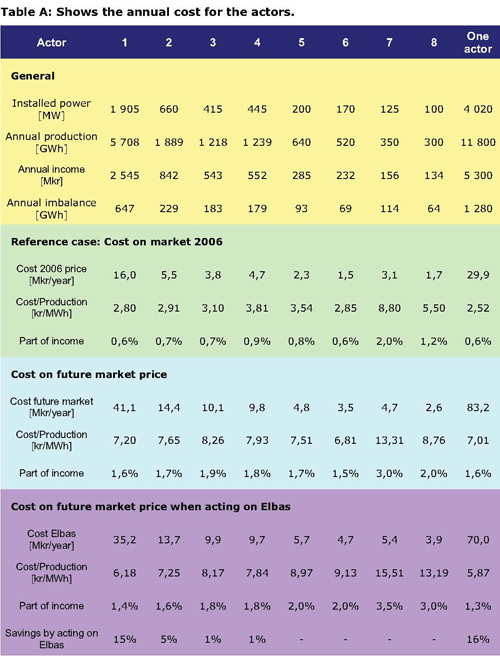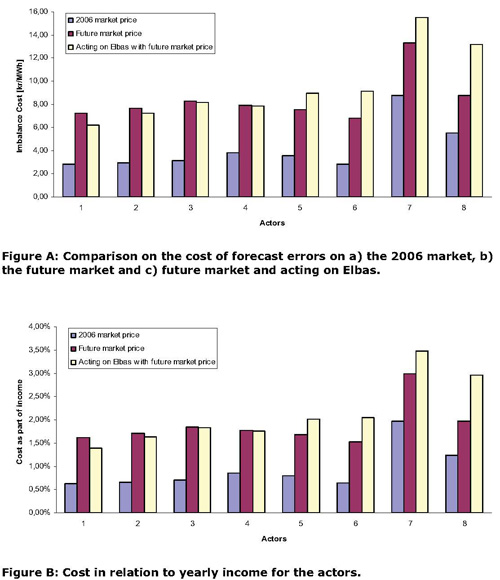Titel: A massive introduction of wind power – Changed market conditions? Elforsk report 08:41
Författare: Fredrik Carlsson, Viktoria Neimane
Utgivare: Elforsk, Vindforsk
Årtal: 2008
Ämnesord: Ekonomi
Sökord/Keywords: Nord Pool, Electric Power Balance,
Rapport
Sammanfattning/Abstract: In Sweden there is an ambitious target to increase the renewable part of the power production. The Swedish Energy Agency has a planning goal of 10 TWh wind energy produced annually by 2015. The newest suggested planning goal
extends the plans to 30 TWh wind energy by 2020. The well-known concerns about wind power are related to its intermittent nature and difficulty to make exact forecasts. Energy from wind power is as all other electrical energy sources sold at the Nordic Power Exchange – Nord Pool. To do that, it is necessary to forecast the production, as the energy for a whole day is sold at 12.00, which means 12 – 36 hours ahead the production hour. Wind power producers do forecasts of their production, by using weather forecasts of wind speeds, and by that estimating their future production. If the producer’s production differs from its planned production, the producer will have to pay for the deviation. Since the electric power system needs to be in balance, the balance responsible for the electric power system needs to order someone (another electric power producer) when there is an imbalance (under- or overproduction) to compensate the imbalance. This is called regulation and costs money for the compensating (regulating) actor. The actors causing the imbalances must pay for their imbalances. The costs are settled according to the regulating prices and distributed among the actors who caused imbalances. The process is called balance settlement and takes place the day after the production day.
If an actor knows that his plan will not be followed, for instance if the actor has an updated wind forecast that tells otherwise, there is an alternative way to go. That way is to buy or sell the imbalance at the adjustment market Elbas, which could be done as near as one hour before the production hour. The drawback of trading at the adjustment market Elbas is that the trade itself costs money and that the new forecast might still not be perfect.
In this report eight different actors have been created, that all have balance responsibility for their production, which means that if they cause an imbalance they have to pay up or down regulating prices. These actors are different in the sense that some are small and some are big, some have concentrated wind farms and some have wind farms that are geographically spread-out. These actors’ wind power sums up to 4 000 MW, and their annual production sum up to almost 12 TWh. The geographical spread-out of the wind power is 50% to the northern part of Sweden and 50% to the southern part of Sweden. An actor called “one actor” has also been created, who consists of all eight actors together. This actor, has two purposes: a) telling how much the wind power together cause imbalance and its costs, and b) if all wind power actors would unite, what could they gain in cost reduction.
The imbalances that these actors cause the system have been modelled using forecast error data from the wind power farm Horns Rev and other publication results of forecast errors. It is well known that the forecast error is reduced if the location of the wind power is spread-out, which has been taken into account in the model. The model gives the answer on the imbalance volume for the actors as well as on the system. To calculate the cost of the forecast errors, a developed price model by Klaus Skytte at Risö Laboratory in
Denmark has been used. This model has parameters that have been estimated for the market situation during 2006. By generating the forecast errors for all actors as random numbers with normal distribution in Excel for a whole year, it has been possible to calculate the actors’ cost for their forecast errors.
Since there is a possibility, to update forecast and placing the forecast error on the intraday market Elbas, this case has been evaluated as well. However updating a forecast will also generate a new forecast error, which of course is in general smaller than the original forecast error. This
has also been taken into account, when calculating the cost for acting on the intraday market.
The costs for the forecast errors by using these two strategies are presented in Table A and visualised in Figure A and B. As a reference, the cost has been calculated by using the regulating prices during the year 2006. It is found that the system’s annual imbalance will increase by 70% from about 1,0 TWh to 1,7 TWh with 4 000 MW wind power in Sweden. The wind power it self generate about 1,3 TWh of imbalances, which means that the wind power will be the dominating source for imbalances. But, the actors will together trade as much as 1,6 TWh/year, although the wind power increase the imbalance with just 0,7 TWh/year, which means that the wind power actors will trade more than twice the amount of imbalances on the regulating market than the wind power will contribute to the system’s imbalance. So most of the trade will be a nonsense trade (55%).
The increased imbalance in the system leads to increased regulating prices, since the regulating prices gets higher as more power need to be bought. Furthermore, an increased imbalance also leads to fewer hours where there is no regulation, which means that the actors have to pay for more hours. When the wind power contributes to the system as such, it also means that the probability that the wind power actor has an imbalance in the same direction as the system increases, which results in an higher amount of hours that the actor have to pay for regulation. These three factors, result in about three times higher costs for the actors, compared to the market today (2006).
The Table A shows clearly, that the actors will have significantly higher costs of imbalances as more wind power installs. The cost per produced energy increases from about 3 kr/MWh to about 7 kr/MWh for larger actors. For small actors, the increase is from about 6 kr/MWh to about 13 kr/MWh. Large actors have the wind power spread out, which reduces the forecast error, which explains why the cost is lower for large actors. However, the cost
related to the income is still low, just in the order of 1% – 3%. Relating the cost to the spot price (ca 450 kr/MWh) also gives a fairly low number.


The possibility to act on the intraday market Elbas is also calculated in Table A. As there are costs associated with acting on Elbas, for instance personnel, buying updated forecasts, trading, etc, the amount of imbalance has to be large enough to make it profitable. The table shows that only actor one and the “one actor” can benefit enough (about 15%) on trading on the intraday market Elbas, compared to leave the imbalance to the regulating market.
Four other scenarios have also been investigated, where a) the wind power has been increased further, b) the spread-out of the wind power in north south direction, c) improved forecasts and d) different price areas. A general conclusion from these are that increased wind power will increase imbalance and costs, concentrated wind power to either north or south will also increase imbalance and cost, improved forecast will of course reduce imbalance and costs, and finally, different price areas will increase imbalance and cost.
The adequacy of the present market structure and alternative solutions for wind power balance settlement in the system with large amounts of wind power is discussed. The present two-price balance settlement system provides good incentives for planning and developing of forecasts. However, assuming large-scale expansion of wind power the system discriminates the smaller actors in a sense that they may face higher imbalance costs and don not have the possibility to reduce the costs by acting on adjustment market. It is important that market-based solutions still supporting the expansion of wind
power are applied. It is also important to point out that alternative market solutions will induce both advantages and disadvantages, therefore the consequences for different affected parties must be analysed carefully.
Finally, it can be concluded that increased wind power will increase the imbalance of the system and therefore increase the regulating costs for wind power actors. Actors with its wind power spread-out (which are mainly large actors) will have lowest prices. Large actors can also benefit from acting on the intraday market Elbas. However, the costs for imbalances are quite small, compared to the income, only in the order of a couple of a percent.
